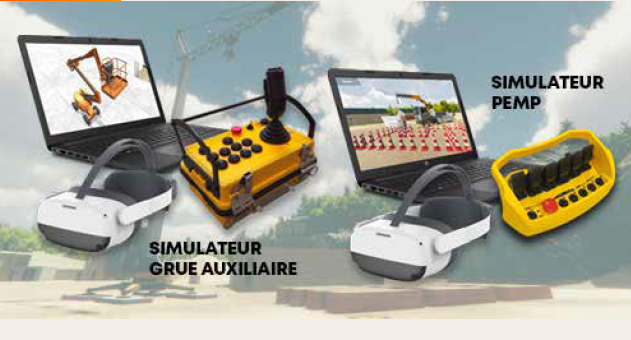AUDACE is particularly attentive to the technological advancements of virtual reality, which is constantly evolving. Every new release, every new announcement is a step closer to a more accessible, immersive, and affordable VR experience.
Standalone VR headsets are a major advancement in the field of virtual reality. They do not require an external PC to operate and are capable of running complex virtual scenes on their own. This technological advancement offers numerous advantages and opens up many opportunities for simulators and digital training.
To illustrate these advantages, Audace has chosen to showcase two of its off-the-shelf simulators: the Auxiliary Crane Driving Simulator and the Aerial Work Platform (AWP) Driving Simulator.
The auxiliary crane is a device mounted at the rear of a truck cabin and is used for lifting heavy loads or pallets. The Aerial Work Platform (AWP), on the other hand, is a mobile personnel lifting device composed of a platform or basket operated by an operator who needs to work at heights. Both of them are operated using a control box with buttons.
The simulators are training tools for safely operating these machines. They provide training on the proper usage of these vehicles while ensuring safety. They allow for preparation and recertification for the CACES® (Certificate of Aptitude in Safe Driving) qualification.
In a virtual environment such as a construction site or a warehouse, the simulators offer learners the opportunity to operate various vehicles and engage in a series of scenarios that they must master, including:
- Operating the controls of the vehicle
- Setting up the vehicle in the work area
- Identifying the various risks associated with the use
- Practical use case scenarios
To provide a training experience that is as realistic as possible, Audace offers solutions that go beyond virtual reality (VR). With our simulators, learners have the opportunity to use the actual remote controls of the equipment. This allows them to gain initial experience that can be easily transferred to real-life situations.
The advantages of standalone VR headsets
Until now, Audace simulators have been operating with a wired VR headset connected to a PC. Recently, the decision has been made to transition them to standalone VR headsets. This change in technology allows for the optimization of our solution by eliminating the need for an auxiliary PC. However, it requires a rethinking of the connection to the remote controls, using Bluetooth technology.
A standalone virtual reality solution
With the elimination of the auxiliary PC, only the headset is now required to operate the simulators. This evolution presents several advantages, such as the elimination of cumbersome cables, simplified operation (everything is managed through the headset), and increased reliability (due to the reduction of devices to maintain). Moreover, this transition allows for cost reduction through savings on PC and VR headset expenses. The standalone version is more financially accessible compared to the wired setup.
A more flexible VR headset ecosystem
With the OpenXR standard, Audace can make its range of simulators and future projects compatible with all models of VR headsets. OpenXR is a programming standard followed by all existing and upcoming virtual reality headsets. By using this standard, Audace develops virtual reality interactions that work across all headset models, providing a seamless and flexible experience. As a result, Audace can offer its clients the VR headset that best meets their needs, regardless of software constraints. This increased compatibility provides an improved user experience and facilitates the selection of the appropriate headset.
A wireless remote control
The transition to standalone VR headsets brings a significant improvement to the use of simulated vehicle remote controls. In collaboration with its partner Itowa, Audace is working on the development of a wireless control box, enabling its solution to be free from any type of cables. This advancement also has the advantage of reducing the setup and installation time of the solution, making it more user-friendly. The other benefit is that it helps reduce costs by eliminating the need for the radio beacon, which was previously required for proper operation.
A wireless remote control
The latest technological advancements in finger tracking, allowing real-time tracking of hand and finger movements, are now available on most VR headsets and have greatly improved in robustness in recent years. Whether it’s making selections in scenario menus or navigating within the virtual world, interactions rely solely on the cameras integrated into the headset. The addition of an additional camera on the front of the headset, such as the Leap Motion sensor, is no longer necessary.
This results in increased autonomy for learners.
With these various advancements and the integration of new interactive menus directly in the headset, Audace simplifies the use of its solutions. As a result, learners will be able to quickly access simulator scenarios and navigate through them independently, without requiring intervention from the instructor through the PC interface, as was previously required.

